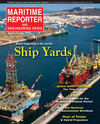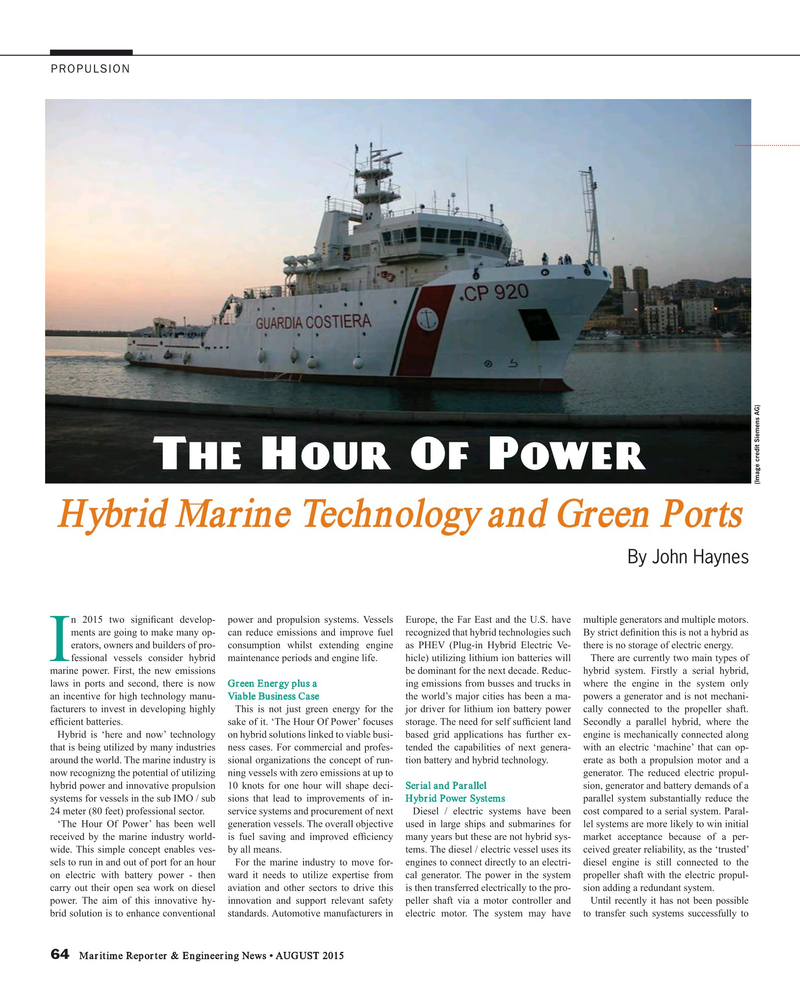
Page 64: of Maritime Reporter Magazine (August 2015)
Shipyard Edition
Read this page in Pdf, Flash or Html5 edition of August 2015 Maritime Reporter Magazine
PROPULSION
The Hour Of Power (Image credit Siemens AG)
Hybrid Marine Technology and Green Ports
By John Haynes n 2015 two signi? cant develop- power and propulsion systems. Vessels Europe, the Far East and the U.S. have multiple generators and multiple motors. ments are going to make many op- can reduce emissions and improve fuel recognized that hybrid technologies such By strict de? nition this is not a hybrid as erators, owners and builders of pro- consumption whilst extending engine as PHEV (Plug-in Hybrid Electric Ve- there is no storage of electric energy.
Ifessional vessels consider hybrid maintenance periods and engine life. hicle) utilizing lithium ion batteries will There are currently two main types of marine power. First, the new emissions be dominant for the next decade. Reduc- hybrid system. Firstly a serial hybrid, laws in ports and second, there is now Green Energy plus a ing emissions from busses and trucks in where the engine in the system only an incentive for high technology manu- Viable Business Case the world’s major cities has been a ma- powers a generator and is not mechani- facturers to invest in developing highly This is not just green energy for the jor driver for lithium ion battery power cally connected to the propeller shaft. ef? cient batteries. sake of it. ‘The Hour Of Power’ focuses storage. The need for self suf? cient land Secondly a parallel hybrid, where the
Hybrid is ‘here and now’ technology on hybrid solutions linked to viable busi- based grid applications has further ex- engine is mechanically connected along that is being utilized by many industries ness cases. For commercial and profes- tended the capabilities of next genera- with an electric ‘machine’ that can op- around the world. The marine industry is sional organizations the concept of run- tion battery and hybrid technology. erate as both a propulsion motor and a now recognizng the potential of utilizing ning vessels with zero emissions at up to generator. The reduced electric propul- hybrid power and innovative propulsion 10 knots for one hour will shape deci- Serial and Parallel sion, generator and battery demands of a systems for vessels in the sub IMO / sub sions that lead to improvements of in- Hybrid Power Systems parallel system substantially reduce the 24 meter (80 feet) professional sector. service systems and procurement of next Diesel / electric systems have been cost compared to a serial system. Paral- ‘The Hour Of Power’ has been well generation vessels. The overall objective used in large ships and submarines for lel systems are more likely to win initial received by the marine industry world- is fuel saving and improved ef? ciency many years but these are not hybrid sys- market acceptance because of a per- wide. This simple concept enables ves- by all means. tems. The diesel / electric vessel uses its ceived greater reliability, as the ‘trusted’ sels to run in and out of port for an hour For the marine industry to move for- engines to connect directly to an electri- diesel engine is still connected to the on electric with battery power - then ward it needs to utilize expertise from cal generator. The power in the system propeller shaft with the electric propul- carry out their open sea work on diesel aviation and other sectors to drive this is then transferred electrically to the pro- sion adding a redundant system.
power. The aim of this innovative hy- innovation and support relevant safety peller shaft via a motor controller and Until recently it has not been possible brid solution is to enhance conventional standards. Automotive manufacturers in electric motor. The system may have to transfer such systems successfully to 64 Maritime Reporter & Engineering News • AUGUST 2015
MR #8 (58-65).indd 64 MR #8 (58-65).indd 64 8/4/2015 9:59:02 AM8/4/2015 9:59:02 AM

 63
63

 65
65
